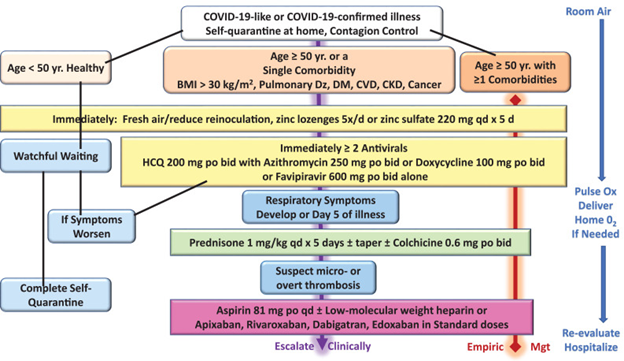Initial symptoms of COVID-19 are not unique and may overlap with many other disorders.
A Cochrane review differentiated four categories of symptoms: respiratory, gastrointestinal, cardiovascular, and systemic. While four major possible red flag symptoms were identified early on (fever, myalgia/arthralgia, fatigue, and headache),[ii] we now know that there may be significant asymptomatic transmission, making control of community spread very difficult. The emergence of significant mutations, including variations in the spike protein, make this novel coronavirus an even greater threat.
Initially, strict social distancing, hand-washing, and face and eye coverings were the main defense against COVID-19. As of April 1, 2021, three vaccines have been granted emergency use status in the United States.[vi]

Source: McCullough, Peter A et al. “Pathophysiological Basis and Rationale for Early Outpatient Treatment of SARS-CoV-2 (COVID-19) Infection.” The American journal of medicine vol. 134,1 (2021): 16-22. doi:10.1016/j.amjmed.2020.07.003. Since January 2020 Elsevier has created a COVID-19 resource centre with free information in English and Mandarin on the novel coronavirus COVID-19. The COVID-19 resource centre is hosted on Elsevier Connect, the company's public news and information website. Elsevier hereby grants permission to make all its COVID-19-related research that is available on the COVID-19 resource centre - including this research content - immediately available in PubMed Central and other publicly funded repositories, such as the WHO COVID database with rights for unrestricted research re-use and analyses in any form or by any means with acknowledgement of the original source. These permissions are granted for free by Elsevier for as long as the COVID-19 resource centre remains active
Conventional approaches to COVID-19 treatments may be life-saving in the acute setting. However, it is vitally important to incorporate fundamental nutrition and naturopathic approaches in the pre-, peri-, and post-COVID-19 period.
[i] Gallo Marin, Benjamin et al. “Predictors of COVID-19 severity: A literature review.” Reviews in medical virology, e2146. 30 Jul. 2020, doi:10.1002/rmv.2146
[ii] Struyf, Thomas et al. “Signs and symptoms to determine if a patient presenting in primary care or hospital outpatient settings has COVID-19 disease.” The Cochrane database of systematic reviews vol. 7,7 CD013665. 7 Jul. 2020, doi:10.1002/14651858.CD013665
[iii] Cao, Xuetao. “COVID-19: immunopathology and its implications for therapy.” Nature reviews. Immunology vol. 20,5 (2020): 269-270. doi:10.1038/s41577-020-0308-3
[iv] Ciotti, Marco et al. “The COVID-19 pandemic.” Critical reviews in clinical laboratory sciences vol. 57,6 (2020): 365-388. doi:10.1080/10408363.2020.1783198
[v] Ciotti, Marco et al. “The COVID-19 pandemic.” Critical reviews in clinical laboratory sciences vol. 57,6 (2020): 365-388. doi:10.1080/10408363.2020.1783198
[vi] CDC. Vaccines and immunizations.
[vii] Cao, Xuetao. “COVID-19: immunopathology and its implications for therapy.” Nature reviews. Immunology vol. 20,5 (2020): 269-270. doi:10.1038/s41577-020-0308-3
[viii] Joyner, Michael J et al. “Safety Update: COVID-19 Convalescent Plasma in 20,000 Hospitalized Patients.” Mayo Clinic proceedings vol. 95,9 (2020): 1888-1897. doi:10.1016/j.mayocp.2020.06.028
[ix] Liu, Miao et al. “Lessons learned from early compassionate use of convalescent plasma on critically ill patients with Covid-19.” Transfusion, 10.1111/trf.15975. 8 Aug. 2020, doi:10.1111/trf.15975
[x] Beigel, John H et al. “Remdesivir for the Treatment of Covid-19 - Final Report.” The New England journal of medicine vol. 383,19 (2020): 1813-1826. doi:10.1056/NEJMoa2007764